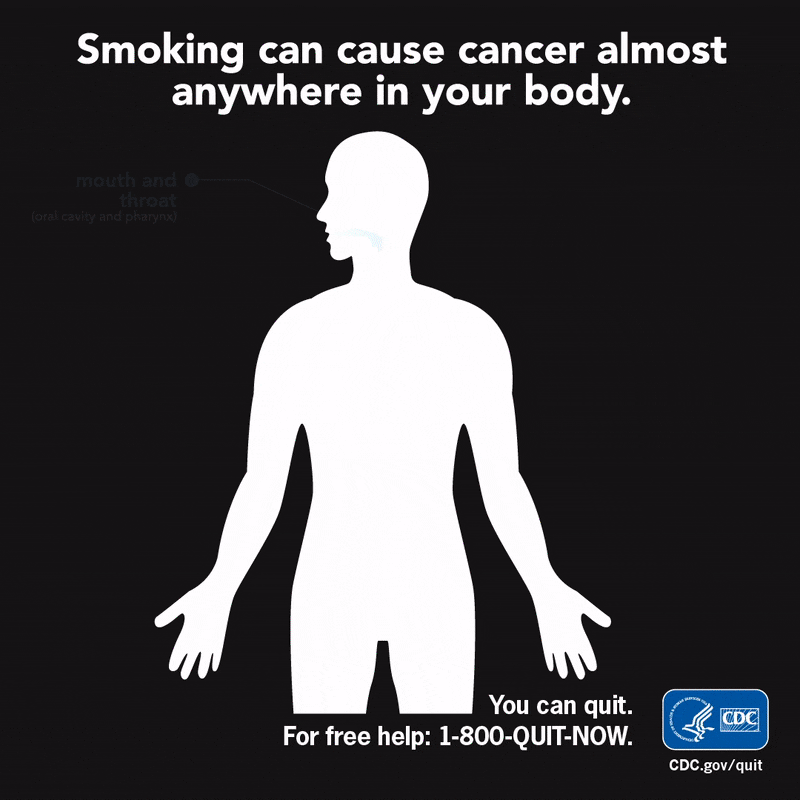Health Effects of Tobacco Use: Youth & Adults
According to the Centers for Disease Control and Prevention (CDC), preventing tobacco product use among youth is critical to ending the tobacco epidemic in the United States. The CDC states all the following:
- Tobacco use is the #1 preventable cause of premature death in America. It causes over 480,000 deaths in the United States each year, and approximately 8,600,000 Americans have chronic illnesses related to smoking.
- If cigarette smoking continues at the current rate among youth in this country, 5.6 million of today’s Americans younger than 18 will die early from a smoking-related illness. That’s about 1 of every 13 Americans aged 17 years or younger who are alive today.
- Youth who use multiple tobacco products are at higher risk for developing nicotine dependence and might be more likely to continue using tobacco into adulthood.
- Most e-cigarettes contain nicotine — the addictive drug in regular cigarettes, cigars, and other tobacco products. Nicotine is highly addictive and can harm adolescent brain development, which continues into the early to mid-20’s. Most e-cigarettes contain nicotine
- E-cigarettes can contain other harmful substances besides nicotine.
- Using nicotine in adolescence can harm the parts of the brain that control attention, learning, mood, and impulse control.
- Each time a new memory is created, or a new skill is learned, stronger connections – or synapses – are built between brain cells. Young people’s brains build synapses faster than adult brains. Nicotine changes the way these synapses are formed.
- Children and adults have been poisoned by swallowing, breathing, or absorbing e-cigarette liquid through their skin or eyes. Nationally, approximately 50% of calls to poison control centers for e-cigarettes are for kids 5 years of age or younger.
- The e-cigarette aerosol that users breathe from the device and exhale can contain harmful and potentially harmful substances, including:
- Nicotine
- Ultrafine particles that can be inhaled deep into the lungs
- Flavorings such as diacetyl, a chemical linked to a serious lung disease
- Volatile organic compounds
- Cancer-causing chemicals
- Heavy metals such as nickel, tin, and lead
The Congressional Findings in the Tobacco Control Act, Surgeon General’s Reports, and other authoritative scientific studies have reported the following:
Smoking costs the United States $193 billion every year from health care costs and lost productivity from premature death. The actual costs are even higher because lost productivity from illness is not included in this estimate.
Smoking among children and adolescents causes their lungs to not fully develop and causes a premature and accelerated decline in lung function beginning in early adulthood.
Data suggest that youth are particularly susceptible to becoming addicted to tobacco.
Virtually all new users of tobacco products are under the minimum legal age to purchase such products.
Retail employees…
one way to prevent the significant adverse consequences of tobacco use is to prevent youth from purchasing cigarettes, smokeless tobacco, and other tobacco products.
Smoking harms just about every organ in the body.

Smoking is known to cause multiple cancers:
| Lung | Kidney |
| Bladder | Acute Myeloid Leukemia |
| Mouth & Throat | Larynx |
| Esophagus | Stomach |
| Pancreas | Cervix |
Smoking is known to cause multiple lung related illnesses:
| Chronic Bronchitis | Pneumonia |
| Reduced Lung Function for Smokers | Reduced Lung Function in adults, youth, & infants from Secondhand Smoke |
| Asthma | Other Respiratory Symptoms |
| Chronic Obstructive Pulmonary Disease | Emphysema |
Smoking is known to cause several other serious health problems, and some that can lead to death:
| Periodontal Disease | Adverse Surgical Outcomes |
| Cataracts | Age-related Macular Degeneration |
| Heart Attacks | Stroke |
| Aortic Aneurysm | Peptic Ulcer Disease |
Women who smoke also have a higher risk of the following:
| Experiencing Reduced Fertility | Giving Birth Prematurely |
| Facing Sudden Infant Death Syndrome with their Baby | Giving Birth to a Low-Birth-Weight Baby |
| Experiencing Hip Fractures | Osteoporosis |
Smoking is also linked to Type-2 Diabetes and Alzheimer’s Disease.